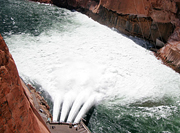Interior Secretary Kempthorne Launches Grand Canyon
High Flow Experiment
Photos
USGS Videos from experiment
Grand Canyon Monitoring and Research Center - 2008 High Flow Experiment site

to initiate water release through jet tubes
PAGE, AZ — On March 5, 2008, Secretary of the Interior Dirk Kempthorne opened the jet tubes at Glen Canyon Dam to release about 41,500 cubic feet per second of Colorado River water into the Grand Canyon. The Secretary’s action launched a scientific experiment aimed at learning more about how to improve the river for wildlife and visitors.
The 60-hour high flow test experiment was intended to push sand built up at the bottom of the river’s channel into a series of sandbars and beaches along the river. This experiment was timed to take advantage of the highest sediment deposits in a decade, and designed to better assess the ability of these releases to rebuild beaches that provide habitat for endangered wildlife and campsites for thousands of Grand Canyon National Park tourists. The water for the experiment was released at a rate that would fill the Empire State Building within twenty minutes and transport enough sediment to cover a football field 100 feet deep with silt and sand.
The sandbars along the Colorado River in Grand Canyon not only provide habitat for wildlife and camping beaches for recreationists, but also supply sand needed to protect archaeological sites. High flows also create areas of low-velocity flow, or backwaters, used by young native fishes, particularly endangered humpback chub. Most sediment entering Grand Canyon National Park now arrives from the Paria River and upper Marble Canyon tributaries below the dam.
The 2008 test differed from previous high-flow tests conducted in 1996 and 2004 because scientists concluded that more sand is needed to rebuild sandbars throughout the 277-mile reach of Grand Canyon National Park than was available in 1996 or 2004. For this experiment, sand supplies in the river were at a 10-year high with a volume about two times greater than the volume available in 2004 due to tributary inflows below the dam.
The high-flow experiment is an inter-agency research effort conducted by three Department of the Interior bureaus – the U.S. Geological Survey (USGS); the Bureau of Reclamation, which operates Glen Canyon Dam on the Colorado River; and the National Park Service (NPS), which manages Grand Canyon National Park. Researchers from Interior’s USGS Grand Canyon Monitoring and Research Center are working with scientists and resource managers from Reclamation, the Fish and Wildlife Service and the National Park Service, as well as the Arizona Game and Fish Department, Northern Arizona University and other cooperators to collect and analyze data from the experiment. A major portion of the research is focused on the well-being of native fish. The humpback chub, an endangered species, is one of four remaining native fish in the Grand Canyon.
The results from the release will be incorporated into the long-term, science-based adaptive management process. Scientists hope to gain a better understanding about whether higher flows created by releasing water from the dam can be used to rebuild eroded beaches downstream. In the time since the 60-hour experiment, USGS scientists have been in the field gathering data to answer a wide range of scientific questions. Preliminary results indicate that the results were mixed but generally encouraging. Compared to the result of the 2004 experiment, scientists are seeing increases in beaches over a longer portion of the river corridor in lower Marble Canyon and eastern Grand Canyon. However, it appears some sandbars were eroded above river mile 20 and in western Grand Canyon
It is important to note that the water released during the test will not change the amount of water to be released over the course of the 2008 water year. That water flows downriver to Lake Mead for use by the Lower Colorado River Basin states and Mexico. The experimental flows are included within this annual volume. Monthly releases later in the year will be adjusted to account for the water released during the experiment.
For more information regarding the science associated with the experimental high flow, visit http://www.gcmrc.gov/research/high_flow/2008/ or contact Lara Schmit at (928) 556-7327 or lschmit@usgs.gov.
For more information, visit www.usgs.gov. The news release and related informational materials profiling the experiment can be found at http://www.gcmrc.gov.
For information on permits and safety, please call Grand Canyon National Park's River Permits Office at 1-800-959-9164 or see http://www.nps.gov/grca/naturescience/high_flow2008-permit.htm.
The Environmental Assessment and Finding of No Significant Impact documents are available at: http://www.usbr.gov/uc/envdocs/ea/gc/2008hfe/index.html.
Click on photo for larger image













